Cultivating Community and Identity: Urban Gardening in Northeastern Columbus’ Bhutanese-Nepali (Lhotshampa) Refugee Community
Cultivating Community and Identity: Urban Gardening in Northeastern Columbus’ Bhutanese-Nepali (Lhotshampa) Refugee Community
By Jennifer Zavon
Following the Bhutanese refugee crisis of the 1980s and 1990s, Columbus, Ohio has become home to one of the largest Bhutanese-Nepali populations outside of Bhutan. Growing food is a common activity among Bhutanese-Nepali refugees, both in Columbus and in other places they have relocated to. For my undergraduate research project, I interviewed 20 Bhutanese-Nepali refugees to learn how growing food in community gardens plays a role in their lives. Gardening can be an opportunity for refugees to hold onto a farming-based cultural identity, socialize, exercise, and access healthy and culturally relevant foods.
Background on the Bhutanese refugee crisis
People of Nepali ethnicity have been living in Bhutan since at least the early 19th century, when they began to settle in southern Bhutan. Settling in the south of Bhutan earned their ethnic group the name Lhotshampas, which translates to “southerners.” Lhotshampas continued to live in southern Bhutan for generations, while maintaining their Nepali language and culture. During the 1980s, the Druk Bhutanese, Bhutan’s predominant ethnic group and that of the current king, worried that the Lhotshampas posed a threat to Bhutan’s political order and traditional Buddhist national identity. This led to the implementation of a “one nation, one people” policy that forced all Bhutanese to practice the culture of the Druk majority by mandating a traditional Druk dress code and removing Nepali language from schools. In the late 1980s many Lhotshampas began to have their citizenship revoked by the government, which led to their displacement and thus, the refugee crisis. After being displaced from Bhutan, it is not uncommon for Lhotshampas to have spent two decades in refugee camps before relocating to new countries.
Research Methodology and Results
During the summer of 2019, I conducted 20 interviews with Lhotshampa refugees at two community gardens in northeastern Columbus. Employees of Ethiopian Tewahedo Social Services (a local organization that provides resources to immigrants and refugees) helped with this process by introducing me to community members and interpreting between Nepali and English during the interviews. In the interviews I asked several questions, but was mainly focused on:
- Why do Lhotshampa refugees choose to grow food in Columbus?
- What positive or negative impacts does gardening have on Lhotshampa refugees’ day-to-day lives?
- Are there any barriers to gardening in Columbus’ Lhotshampa community?
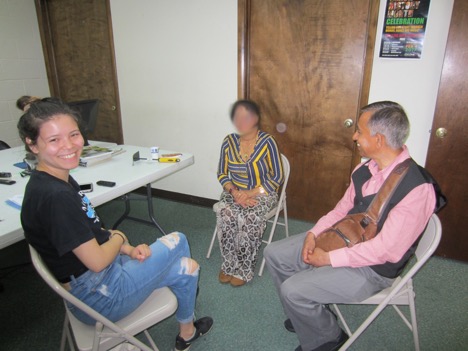
Myself (left) interviewing a community member (center) near Garden A with the help of an interpreter (right). Photo by Cathy Rakowski, author’s research advisor, and edited by author.
I am in the process of compiling my results from the interviews, but so far, I have found a number of main themes repeated by several respondents:
Cultural identity: Farming was the main livelihood in southern Bhutan. In my interviews, respondents often mentioned how they had farmed back home in Bhutan and had continued to grow food (by sharecropping or having a kitchen garden) while living in refugee camps in Nepal. Some had also farmed or gardened in another US city before moving to Columbus. Continuing to grow food in the US was a way for some Lhotshampa refugees to connect with happy memories from the past, and to maintain their identity as farmers. Many people I spoke with also used working in the gardens as an opportunity to teach children and grandchildren how to grow food.
Culturally relevant food: Growing their own food was a way for some Lhotshampa refugees to easily access foods particular to traditional Nepali dishes. Among these were broad leaf spinach (saag) and a type of mustard leaf used in making one of the national foods of Nepal, a pickled vegetable dish called gundruk. Other foods grown included beans, potatoes, squash, okra, radishes, parsley, tomatoes, hot peppers, salad greens, cilantro, carrots, cauliflower, cucumbers, and mint.
Health and exercise: Many people I interviewed mentioned the health benefits of growing one’s own food. They felt satisfied by working with their hands and bodies in the gardens, viewing growing food as a form of exercise. Additionally, they liked knowing that the food they grew for themselves was fresh and organic.
Socializing and building community: For most respondents, gardening was a social activity done with family and friends. Almost everyone I spoke with expressed that they shared the food they grew with family, friends, and neighbors. Most people I interviewed were between the ages of 40 and 70, and many had few opportunities to integrate into American culture. However, gardening alongside other Lhotshampa community members provided a daily opportunity to socialize and meet new people without the need for complete cultural integration.
Barriers to gardening: Although each community garden I visited had a limited number of plots and the demand for plots seemed to be high, most people I interviewed claimed not to know of others in the local Bhutanese-Nepali/Lhotshampa community who wanted to grow their own food but were unable to do so. Nevertheless, I think expanding the amount of land available for community gardening would lead to more positive impacts for Lhotshampas in Columbus. With the current enthusiasm for growing food and the sizable Lhotshampa community here, I believe additional land dedicated for gardening would not go to waste.
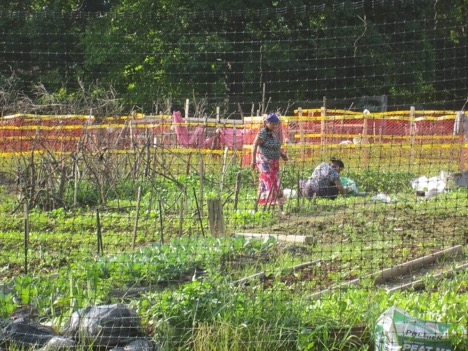
Women working in Garden A. Both gardens were partially supported by a church that owned the land at each site (a separate church supported each garden). The church collected $20-$25 per plot from gardeners each year, and sometimes provided seeds and manure to gardeners throughout the season. Photo by Cathy Rakowski.
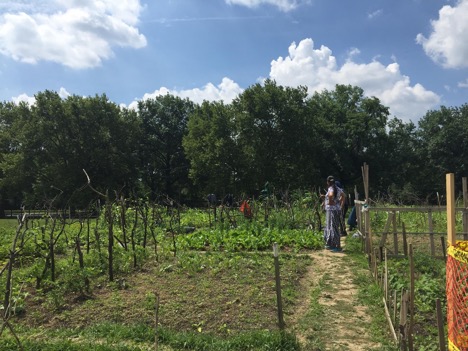
Garden A. Photo by author.
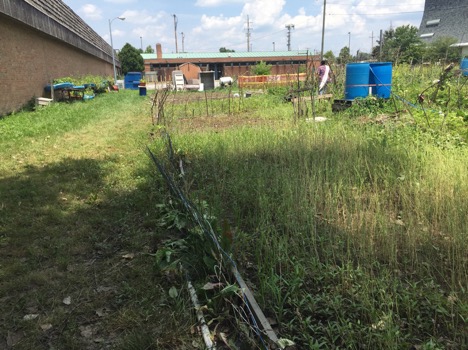
Garden B. Photo by author.
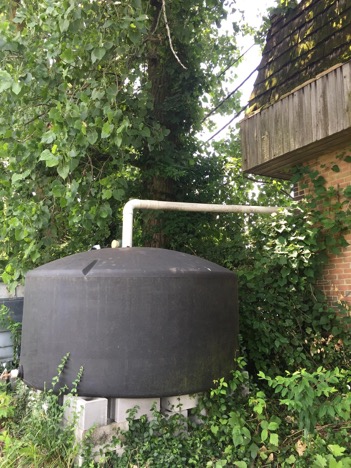
Rainwater collection at Garden B. Both gardens had a tank that collected rainwater, which could be taken and used by gardeners. Photo by author.
One of my favorite questions to ask was “why do you farm?” These are some of the responses I got (interpreted from Nepali):
“Because I remember the farm there in Bhutan. [Gardening] here, I will reconnect with the farm, reconnect those memories of the past in Bhutan… that makes me happy… when I sow the seeds, I want to see the plants germinating and growing.”
“To eat good food.”
“Since I have been farming, I get refreshed when I do the work and if I stay without work in the home I have tension, so that has minimized the tension, doing work here. If I stay home, I have more tasks, stress.”
“Back in our country we used to grow our own vegetables, so we like to grow our own vegetables here.”
Moving Forward
I hope that sharing the results of this project will create more discussion around the benefits of community gardening. While I looked at the role of community gardening among Lhotshampa refugees, gardening programs have proven to help refugees from around the world access tasty and familiar foods and practice a hobby they enjoy, for an example, see Global Farms in St. Louis.
Columbus and Franklin County’s Local Food Action Plan, which outlines goals and action steps for a sustainable, fair, local food system, includes specific recommendations to increase residents’ capacity to grow their own food, develop food markets that reflect neighborhoods’ cultural diversity, and engage New Americans and other underrepresented communities in developing culturally appropriate food assistance, nutrition, and gardening programs. By creating more opportunities for people to utilize community gardens like the ones I visited, Columbus could be taking steps towards all of these goals.


Comments (1)